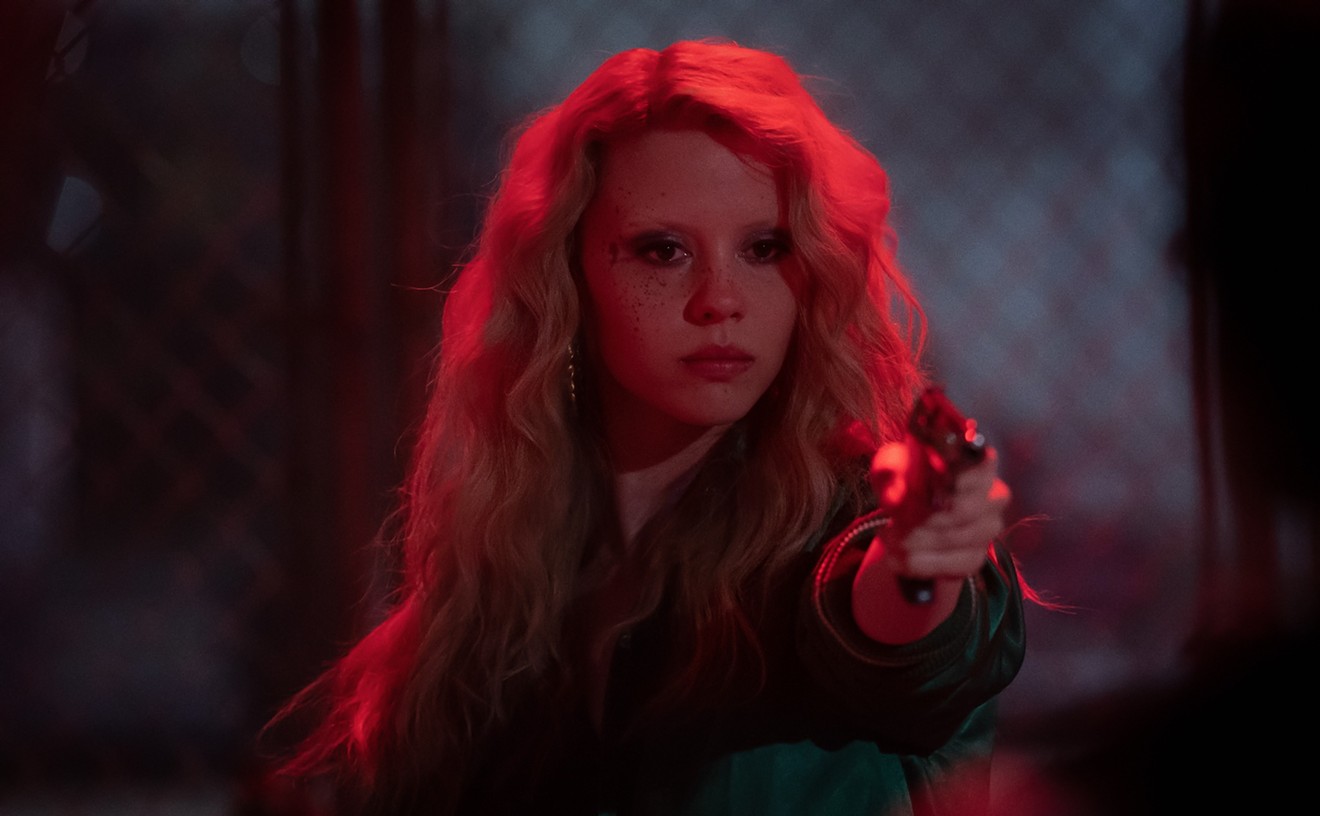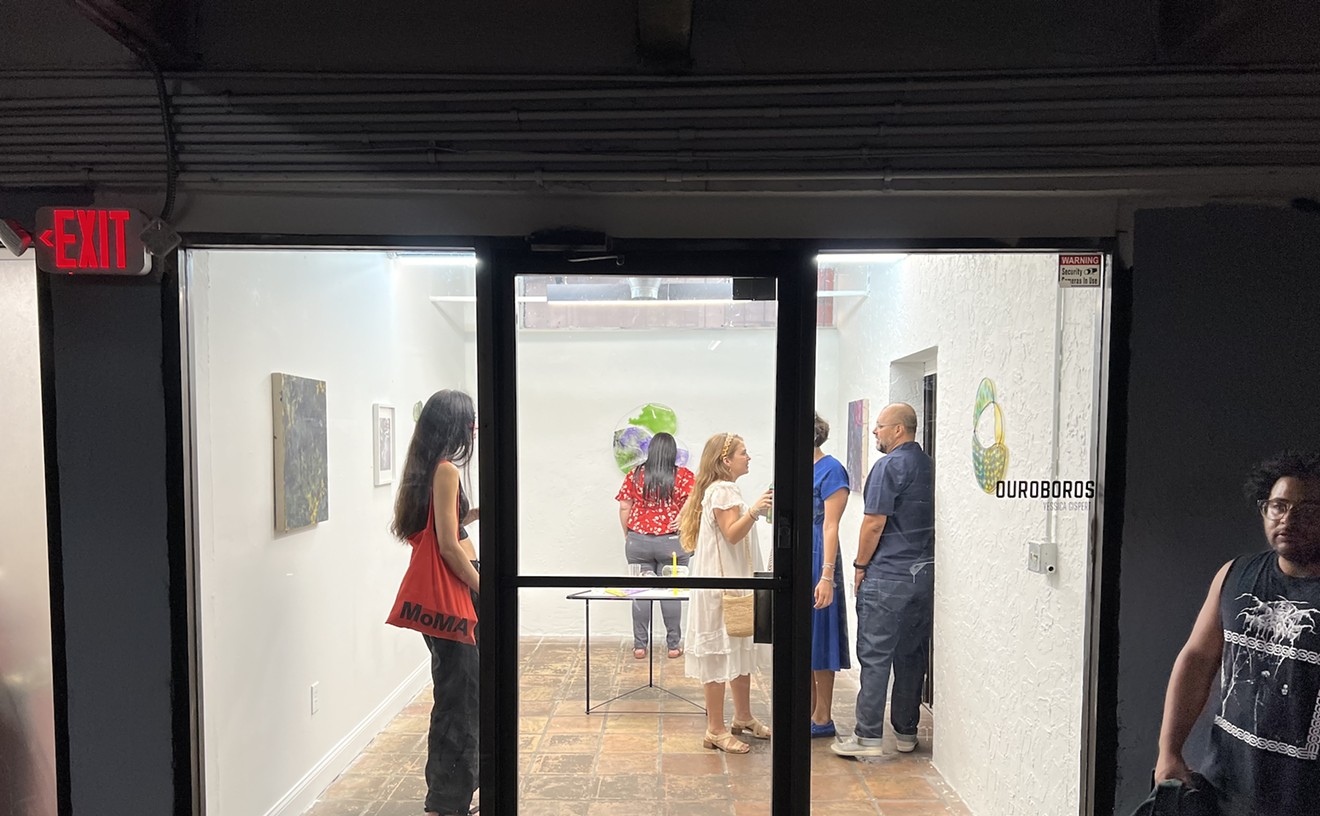The Thunderbird was one of many motels that architect Norman Giller designed for the stretch of Collins Avenue between 155th and 194th streets, the oceanside location of a postwar fantasy that became known as Motel Row. Predating Disney World and Morris Lapidus's kitsch palaces farther south on Miami Beach, the Sunny Isles motels built by Giller and a handful of other pioneers were early monuments to the newfound leisure time of the modern era's middle class.
When construction began on the Thunderbird in the spring of 1955, the strip already looked like an oversize miniature golf course, lined with a carnival arcade of flashing lights and beckoning figures that included the concrete sphinxes that still guard the Suez; the "oasis" in front of the Sahara Motel, inhabited by five sculpted camels and two robed Arabs, whose thuggish features make them look more like Gerard Depardieu than Lawrence of Arabia; the Colonial Inn's genteel white horses and carriage; the Day-Glo Tiki masks mounted by the doors of the hot-pink and white Waikiki; that motel's Swinger Lounge, decorated with sequined hula girls in relief. Blue Grass, Tahiti, Bali, the ingenuously named Sun City, and dozens more were designed to appeal to new tastes for reasonably priced vacation adventures.
It was Giller, a Florida native who has lived in Miami since 1929, who started it all. In 1949 his firm built what is believed to be the first two-story motel in the United States A the Ocean Palm at Collins Avenue and 157th Street, still in business today. "Up until then, motels only had one floor, since the whole idea was that you could drive your car right up to the room," remembers Giller, now 77 years old and still active. (He works with his son out of their office on Arthur Godfrey Road, tackling projects such as the renovation of the Netherland on Ocean Drive.) "My clients weren't sure if people would walk up an extra flight," Giller explains. "It turned out they would -- the place was full from the first season." And the resort motel was born.
Economical but packed with amenities that included newfangled air conditioning, multiple swimming pools, and organized recreational activities (they frequently took place in the cocktail lounge), the mod new motels were described in the press as an affordable option to Miami Beach's more distinguished hotels. "The architecture is flamboyant, super-modern, tropical," gushed an article about Motel Row in the July 1952 issue of Tourist Court Journal. "The atmosphere is deluxe, almost pleasantly snobbish."
The first motels settled on predictable seaside names such as the Green Heron and the Castaways. But as the area became more thickly settled, the owners chose increasingly exotic monikers, which also served to provide decorative themes, carried out in the lobby areas and guests' rooms, and culminating in the eye-catching concrete sculptures outside, some up to 40 feet high.
"The motels were geared toward the family tourist," Giller points out. "They presented a more economical alternative to the hotels in Miami Beach. And to make that alternative more attractive, they began to use the various themes. That made them a tourist attraction. It gave people a place to take pictures of themselves and send them home."
"It was a thing we did to differentiate ourselves," adds Mel Rubel, the 74-year-old owner of the Blue Mist on Collins and 191st, a two-story building flanked by the "Maids of the Mist," a pair of curiously monstrous goddesses who wear ocean waves for dresses and who hold crescent moons over their heads. Created by a mason with artistic ambitions who happened to be working on the construction site, the "maids" still stand at the Blue Mist. "There were so many motels," notes Rubel. "This was a way that the guests could remember which one they were staying in."
Giller explains that the client usually picked the theme for the hotels he designed: a rustic look and a pelican logo for the Driftwood; a Roman soldier in a toga and kicky sandals for the Dunes; an Egyptian look for the Suez; an American Indian motif for the Thunderbird. The architects themselves often designed the sculptures and the painted logos, although occasionally an outside artist was commissioned.
"We would use the motif throughout the building, and make the design of the motel half modern and half thematic," Giller says. Sometimes the choice for a decorative theme was left up to the architect himself. Giller's firm came up with the name the Fountainhead for the motel they built at 160th Street and Collins, commemorating the 1943 Ayn Rand novel about the trials of a misunderstood and visionary modern-age architect, … la Frank Lloyd Wright. Waterfalls ran down the hotel's facade. "Oh, yeah, we really had fun in those days," Giller sighs wistfully.
The architects weren't the only ones having a ball. The current South Beach scene has nothing on vintage Sunny Isles. Frank Sinatra and Ava Gardner spent their honeymoon there. Motel brochures promised "gay and exciting fun" at nightly events that included square-dance jamborees, Hawaiian parties, and Rebel nights: "You'll get your Rebel hat and Rebel flag and you will eat Southern Fried Chicken." In 1964 the Beatles headed for the Castaways' Wreck Bar after taping a segment for the Ed Sullivan Show in Miami Beach. Guests at the Suez gathered round the motel's sphinxes to watch the filming of Blood Feast, a gory Sixties exploitation film about an Egyptian caterer gone mad, now considered a classic of the genre.
As late as 1968 the Sunny Isles scene was still going strong. A Miami Herald headline proclaimed "Like a psychedelic experience, it's wall-to-wall neon on Sunny Isles A motel strip's the go-go-ingist!" However, like Miami Beach and other areas of Miami, Motel Row went into decline in the Seventies. More recently there has been a resurgence of sorts, and the motels now are packed with the overflow of foreign tourists who can't afford South Beach. A small chain of motels on the strip has been renamed Varadero (the name of a popular beach in Cuba), and the receptionist at the Fountainhead Motel answers "Buenas tardes, Fountainhead." The motels are no longer luxury resorts, just cheap places to stay, but the guests still pose by the statuary landmarks outside.
Some motel owners, such as Rubel, have refused to turn a profit by selling their land to developers. Looking fondly around his lobby, which is decorated with star-shape lamps and midnight-blue leatherette lounge chairs, the Blue Mist proprietor laughs and says, "It will be around as long as I'm around." (Nearby, at the Suez, Robert Lucas and his son, also named Robert, still preside.)
Still, at least a dozen motels have been demolished to make way for high-rises. "There's only so much oceanfront property, after all," warns Giller. "Somewhere down the road, the lot of them will be replaced with other types of structures."
Sad thing is that few people other than the original hotel owners seem to care. There are no kitsch crusaders fighting to preserve these roadside attractions, South Florida's spectacular contribution to that particular type of pre-pop American folk art that also includes giant polyurethane steak-house steers and taco stands in the shape of Mexican sombreros. Nicholas N. Patricios, author of the academic tome Building Marvelous Miami, published last year by the University Press of Florida, is typical. Patricios documents and analyzes at length the Art Deco, Streamline Moderne, and International-style buildings in the area, but he doesn't even mention the cultural contribution of the Sunny Isles resort motels.
Even while the Thunderbird spruces up its original trademark design, other motels and their concrete fantasies continue to fall. The most recent victim was the Heathwood Motel, razed to make way for a new condo tower. All that's left on the now-vacant lot at 186th Street and Collins Avenue is a lonely slab of a "medieval" stone, its plaster coat of arms depicting a slowly eroding sea horse, its moatlike fountain run dry.
Artyfacts
The art market in the Nineties has grown increasingly inhospitable to high-priced, large-scale paintings (and oversize egos), with the art stars of the Eighties having taken to disseminating their creative seed in other directions A to widespread critical disdain. Early this year, painter David Salle thrust his star-studded flop of a movie, Search and Destroy, in front of an unsuspecting Miami Film Festival audience, and even as you read this, painter and video maker Robert Longo's cyber-disaster, Johnny Mnemonic, is making its way from area screens to the shelves at Blockbuster. Now Julian Schnabel has begun filming his biopic about fellow famous New York City painter Jean-Michel Basquiat, who died of a heroin overdose in 1988 at age 27. A report on the production in a recent issue of the New Yorker described the artist's casual, all-in-the-family approach to filmmaking A Schnabel's father and daughter are among a cast that also features the artist's buddy David Bowie as Andy Warhol.
Meanwhile, Schnabel has recorded an album, Every Silver Lining Has a Cloud (Island). This ego-stroking release features none of the kind of artsy aural experimentation that characterized the sound works made by conceptual artists in the Seventies (Bruce Nauman, Jill Scott). A well-produced CD, with cover art that depicts a bug-eyed angel staring out from behind a towering black phallus, it features Schnabel singing thirteen original urbane ballads flecked with a country and western twang.
Co-written by the artist and several collaborators, the album's often self-mocking musings on love and heartbreak in the city, growing old, and bullfighting are reminiscent of songs by Leonard Cohen or Lou Reed. And yet Schnabel's schmaltzy vocal inflections more closely resemble those of Tony Bennett, and his gravelly voice, affecting a Southern accent, comes off as an Elvis Presley imitation. (Come to think of it, put him in a glitzy white polyester jumpsuit and big sunglasses, and the hefty New York painter would bear a remarkable resemblance to the King himself -- "Elvis sighted in Soho loft!") Despite what one might expect, the album sounds pretty good, thanks in part to engineer Oz Fritz and co-producer (with Schnabel) Bill Laswell. The music's melancholy mood has a kind of lazy Sunday afternoon appeal, and Schnabel, who really has no voice to speak of, talks his way through a lot of the album, managing not to take himself too seriously. While definitely not destined for the Top 40, Every Silver Lining Has a Cloud has a promising future as a cult classic. Coming soon to a CD Solution near you.










